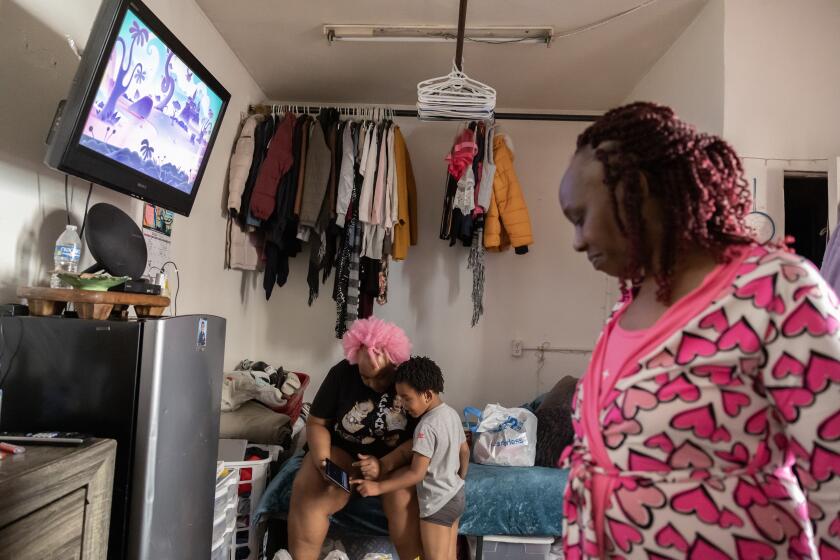Census Workers Count 228,621 Homeless Across U.S. : Population: Advocates quickly denounce the figure as a gross undercount. California’s total of 49,081 is the largest in the nation.
The Census Bureau said Friday that it counted 228,621 homeless people across the country a year ago--including 49,081 in California--but the tally was criticized immediately by advocates for the homeless as far short of the true figure.
The preliminary count consists of 178,828 people who were residing in homeless shelters and 49,793 who were living visibly on the streets during the night of March 20-21, 1990, when census enumerators attempted to count those without homes.
In California, 31,000 people were counted in shelters and 18,081 on the streets, the bureau said. The California number was the largest in the nation.
New York had the nation’s second-largest homeless population, with 32,472 living in shelters and 10,732 on the streets.
Census enumerators counted 7,706 homeless people within the city limits of Los Angeles, of which 4,597 were in shelters and 3,109 were on the street, the bureau said. Total counts for other California cities were 5,569 in San Francisco, 4,947 in San Diego and 1,552 in Sacramento.
Homeless advocates quickly denounced the government’s figures as a gross undercount. While projections of the nation’s homeless population vary widely, most advocates accept the Urban Institute’s 1987 estimate that at least 500,000 people are homeless on any given night.
Moreover, few advocacy organizations cooperated with the government’s effort to count the homeless, saying that it was a poorly executed program aimed at masking the nation’s refusal to grapple with a lack of affordable housing for the poor.
“The census numbers fit nicely with the admitted strategy of President Bush’s advisers to minimize the extent of domestic problems,” said Joan Alker, a spokesman for the National Coalition for the Homeless in Washington.
Cynthia Taeuber, a Census Bureau specialist on homeless population, said that the figure is preliminary and does not represent an attempt to quantify precisely the actual homeless population.
However, she acknowledged that the numbers are incorporated in the nation’s total population of nearly 250 million and would be used in federal revenue-sharing programs that are based on census data.
“As part of the official census data, they will be used as the census data is used and added to the appropriate jurisdictions,” she said. “But we have urged caution in using the figures as an accurate count of the homeless population.”
She said that additional figures accounting for people often considered homeless--such as those living in shelters for abused women, alcohol and drug detoxification centers or homes for unwed mothers--would be added later this year to the preliminary homeless count.
Even with those figures included, she added, the total still will not account for every American without shelter because many homeless people aggressively evade enumerators. “We will never have a total homeless count,” Taeuber said.
Bureau officials sent about 15,000 enumerators into 14,200 of the 39,000 local governmental districts across the nation on that single night in March, 1990. The counters visited about 10,600 shelters and 11,000 outdoor locations looking for the homeless. They were given strict instructions to count only those people in plain view and not to poke around in garbage dumps, abandoned buildings or other places where the homeless might hide.
Officials said that they believe a high proportion of the homeless were counted in urban areas with populations greater than 50,000, where most of the nation’s homeless shelters are located. They had less confidence that they reached homeless people living in smaller towns and rural areas with fewer shelters and more open spaces.
“The shelter count is a good count and that’s the biggest component of the (homeless) population,” Taeuber said. “But we have no idea whether we counted a large part or a small part of the street population. The best we can say is that we added about 50,000 people to the total population that would not have been counted.”
Homeless advocates who dispute the bureau’s figures join an already long list of disgruntled groups complaining about the 1990 census. Big city mayors and state government officials have sued the Census Bureau to compel it to adjust the final figures with statistical data. Two states, Washington and Oklahoma, have sued to prevent the bureau from changing the count.
Start your day right
Sign up for Essential California for news, features and recommendations from the L.A. Times and beyond in your inbox six days a week.
You may occasionally receive promotional content from the Los Angeles Times.



